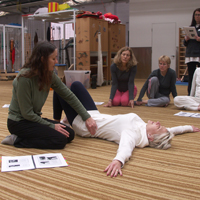Therapist Amazed at Effectiveness of Innate Rhythmic Movements
Submitted by Angela Rue, COTA/L

|
Before
|
After
|
|
Inability to toilet train
|
Improved toilet training
|
|
Inability to hold a crayon correctly and color
|
Improved grasp and pre-writing strokes
|
|
Gross motor challenges
|
Crosses midline more easily
|
|
Difficulty with transitions and changes in routine
|
Accepts changes in routine more easily
|
Amanda was referred for occupational therapy due to delays in fine motor, gross motor, sensory processing, ADL’s, difficulty with transitions, and difficulty accepting change in her routine. She has been receiving OT at the rate of 2 times a week for 60 minutes for 4 months. In total this would equal 32 hours of occupational therapy with reflex integration. She is 3 years, 10 months and has autism.
Mother reports several areas of concern: inability to toilet train, difficulty with transitions and changes in routine, poor tolerance for wearing clothes, inability to hold a crayon correctly and color, poor tolerance for grooming activities, and difficulty with self-regulation.
Amanda demonstrated maximal distress with all sensory based/gym activities presented and preferred to sit at the table. Innate rhythmic movements [from the Brain and Sensory Foundations course] were slowly introduced over a 4-week period in the clinic setting. Therapist instructed her mother in innate rhythmic movements, however Amanda refused to allow her mother to complete them in the home environment. Slowly over the next 2 weeks her therapist was able to transfer the movements to her mother and she completed them 2 times a day along with The Wilbarger Deep Pressure Proprioceptive Treatment and Therapeutic Listening.
Indicators present for the following retained/unintegrated primitive reflexes: Asymmetrical tonic neck reflex, Symmetrical tonic neck reflex, Spinal Galant reflex, Moro reflex, FPR, Babkin reflex (hands), Plantar/Babinski reflexes (feet)
Innate Rhythmic Movements were continued along with targeting the Moro and FPR. [from the Brain and Sensory Foundations course] Once Amanda was comfortable with the Moro and FPR exercises I decided to target the Spinal Galant reflex due to her having difficulty with toilet training and her aversion to wearing clothing. Testing indicated retained Spinal Galant on both sides. Amanda also never leans back in her chair when seated at tabletop. Her back also was extremely sensitive during completion of therapeutic brushing. Integration was targeted with [activities from the Brain and Sensory Foundations course]. Her Mother was excellent about following through with integration in the home environment. Next, we targeted the ATNR and STNR. I started with ATNR isometric activities in supine for 1 week and then introduced them in prone. Amanda tolerated well and we added STNR activities.
Rhythmic movement # 1 was continued and rocking on hand and knees was introduced. Hand and feet reflex integration [from the Brain and Sensory Foundations course] was introduced last. Improvements noted with transitioning, self-regulation, and tolerance for grooming ADL’s. Improvement was noted with toilet training, grasp on writing utensil, pre-writing strokes, crossing midline, and accepting change in routine.
Amanda made so many gains that her occupational therapy was able to be reduced to 1 time a week.
I believe that the tools I learned from this course were key in the rate of Amanda’s progress. I also am amazed at the effectiveness of the innate rhythmic movements. Her Mother reports that she will often see Amanda doing them on her own.
(Edited, emphasis added)


